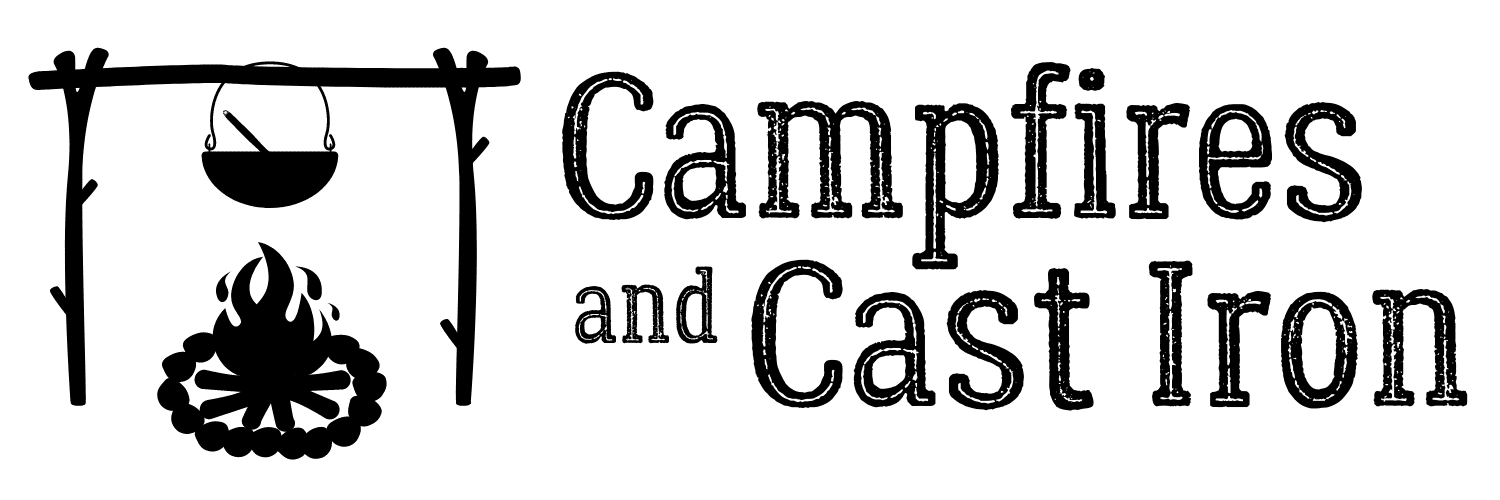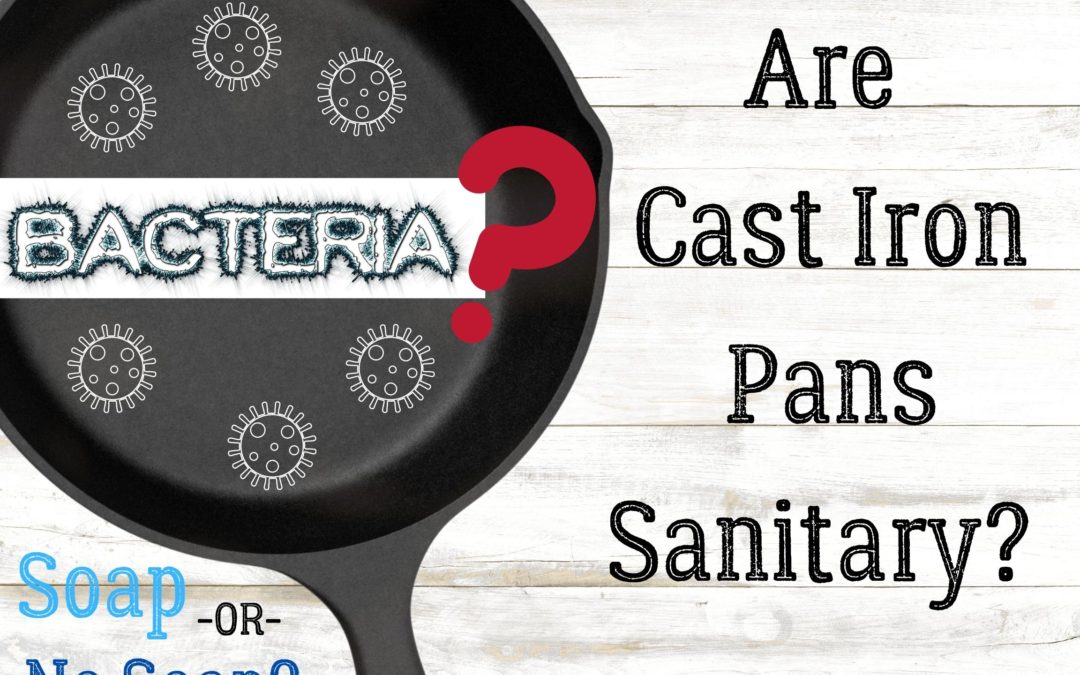Last updated on August 24th, 2022
Do you ever wonder if cast iron pans are sanitary, especially if you don’t use soap to wash them? You hear people talking about just wiping out the crumbs or simply rinsing cast iron pans with water after cooking a meal. After all, this is what generations of cast iron users have been doing for over a hundred years. But, is this really a good idea? Won’t bacteria grow on your cookware and make you sick?
Cast iron pans are sanitary if cared for properly. After each use, wipe or rinse out the skillet. Then, heat it on the stovetop or in the oven for three to five minutes to kill bacteria. Pre-heating cast iron pans to 160 degrees or greater prior to cooking will also kill bacteria and viruses. Washing with mild soap is also okay.
In this article, I’ll show you why cast iron cookware is both sanitary and safe to cook with. I’ll also show you how to properly clean and sanitize your cast iron pans and why it’s okay to use soap to clean them, although it isn’t required.
Are Cast Iron Pans Sanitary If You Don’t Use Soap?
This is probably one of the most frequently asked questions when it comes to cleaning cast iron cookware: Are cast iron pans sanitary – are they truly clean and safe to cook with – if you don’t wash them with soap? Actually, yes! To understand why, let’s take a look at the science behind this answer.
The secret to clean and sanitized cast iron cookware without using soap is really quite simple: Heat. Just like it’s essential to cook meat to a high internal temperature for food safety, usually 145 to 165°F depending on the type of meat, it’s important to heat cast iron cookware to similar temperatures to kill any bacteria that may remain on the pan after cooking and rinsing it out.
Let’s take a more specific look at what happens to bacteria and viruses when exposed to high heat. According to this technical brief published by the World Health Organization (WHO), studies show that “…Bacteria are particularly sensitive to heat, and rapid kills – less than 1 minute per log (90%) reduction – are achieved at temperatures above 65°C [149°F]. Viruses are inactivated at temperatures between 60°C and 65°C [140°F and 149°F], but more slowly than bacteria. However, as shown for poliovirus and hepatitis A, as temperatures increase above 70°C [158°F], a greater than 5 log inactivation (99.999% reduction) is achieved in less than 1 minute.”
While it is important to note that these studies were specifically aimed at analyzing the effects of heat on bacteria and viruses in liquids (boiling contaminated water to make it safe to drink), the same principles apply to using heat to disinfect hard surfaces, such as cast iron cookware.
Heating Cast Iron Cookware To Kill Bacteria: An Experiment
Since we now know that temperatures of 160°F and higher are sufficient to kill bacteria on cast iron cookware, I became curious about a few things: How hot does a cast iron skillet actually get when heated on a stovetop burner or in the oven? Also, how long does it take for both the inner bottom surface and sidewalls of the skillet to reach a temperature of 160°F?
I decided to conduct an experiment in my kitchen to answer these questions and help determine the optimal heating method and time required to sanitize cast iron cookware.
Materials
- I used a 12-inch Lodge cast iron skillet for this experiment.
- To measure the temperature, I used a digital infrared laser thermometer with a temperature sensing range of -58°F to 1022°F. I adjusted the emissivity (amount of thermal energy emitted from a surface) setting to 0.80 for cast iron as indicated by the instructional booklet.
Method
- I began by taking baseline temperature readings on both the inside bottom and inner sidewalls of the skillet at room temperature, as pictured below.

- I then placed the skillet on a large electric stovetop burner and turned it on to heat setting 3.
- I timed the heating of the skillet and took temperature readings on the inside bottom and sidewall just under the pour spout at 3 and 5-minute intervals and recorded the data in the chart below.
- The skillet was removed from the burner and allowed to cool to the baseline temperature before proceeding to the next test.
- The heating procedure was performed again at stovetop burner heat setting 6 and temperatures were recorded at 3 and 5-minute intervals.
- Once again, the skillet was removed from the burner and allowed to cool to the baseline temperature before proceeding to the next test.
- For the last test, I preheated my electric oven to 350°F, then placed the skillet on the middle rack. I checked and recorded the bottom and sidewall temperatures at 3, 5, and 10-minute intervals and recorded the data.
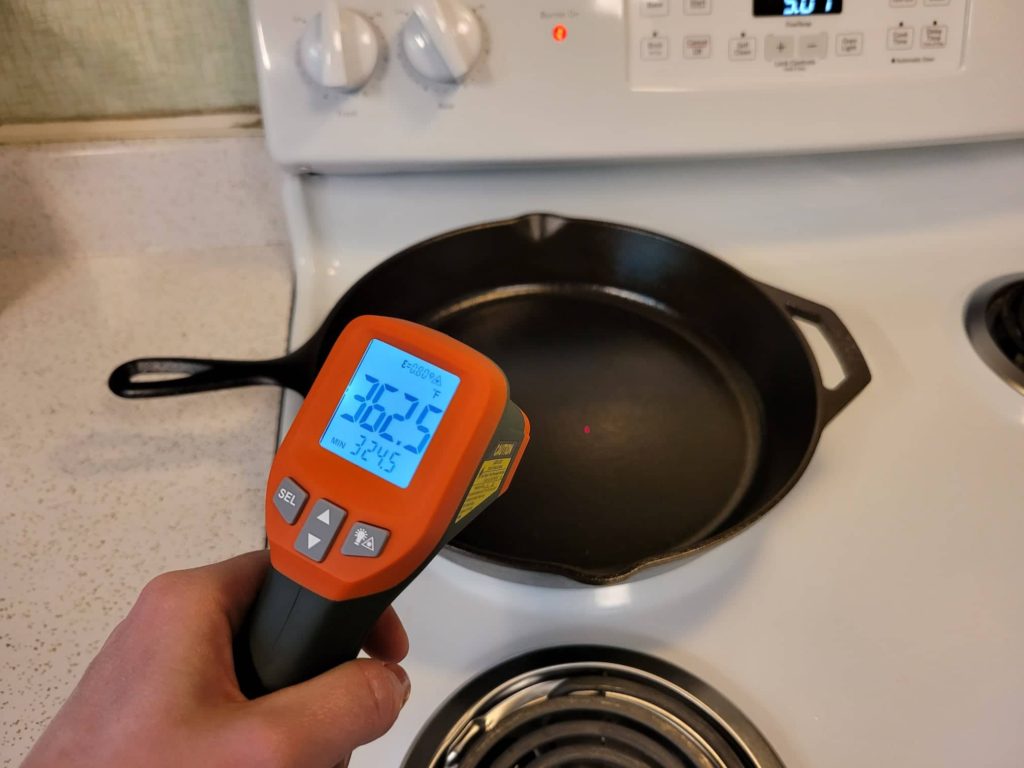
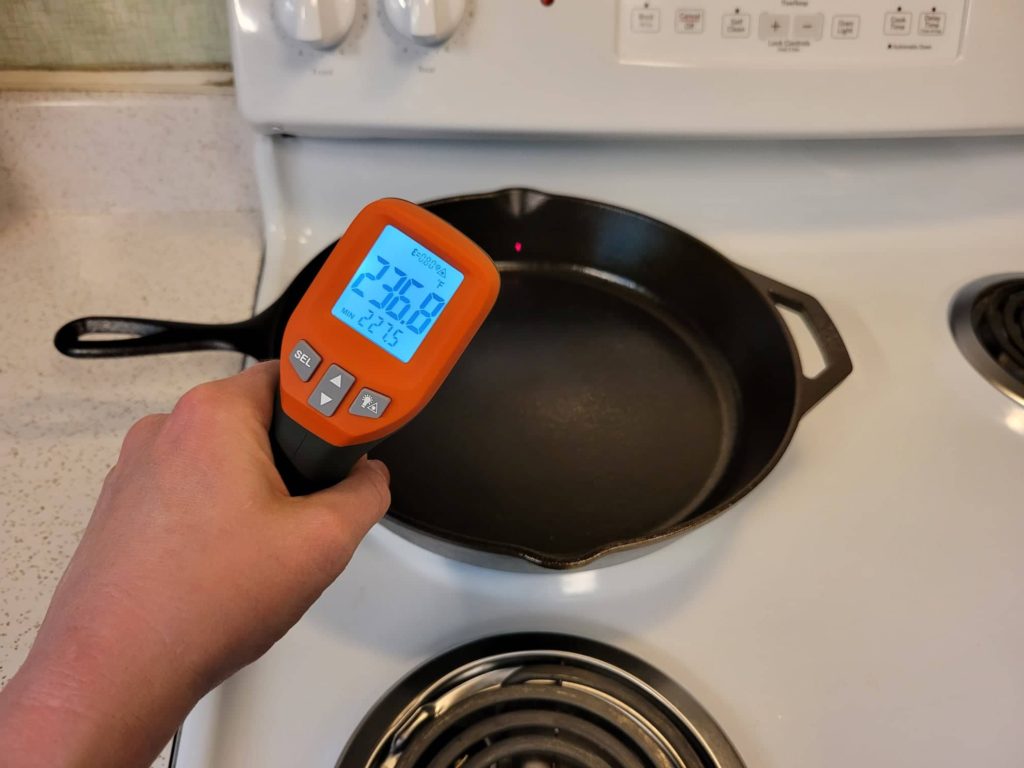
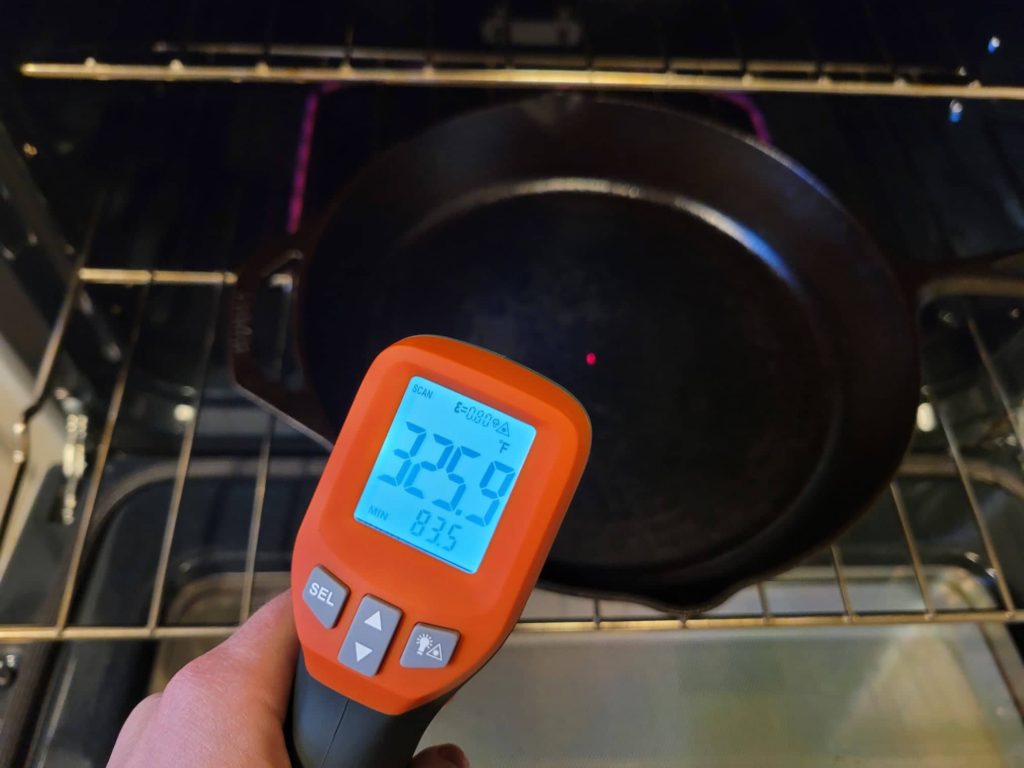
Cast Iron Skillet Temperature Data Chart
| Heat Setting | Time Heated | Skillet Temperature |
| No Heat – Baseline Temperature | 0 minutes | Bottom: 72.0°F Sidewall: 72.0°F |
| Burner Setting 3 | 3 minutes | Bottom: 209.5°F Sidewall: 103.6°F |
| Burner Setting 3 | 5 minutes | Bottom: 264.6°F Sidewall: 130.5°F |
| Burner Setting 6 | 3 minutes | Bottom: 362.5°F Sidewall: 150.1°F |
| Burner Setting 6 | 5 minutes | Bottom: 538.9°F Sidewall: 236.8°F |
| Oven set at 350°F | 3 minutes | Bottom: 226.2°F Sidewall: 202.5°F |
| Oven set at 350°F | 5 minutes | Bottom: 263.5°F Sidewall: 225.6°F |
| Oven set at 350°F | 10 minutes | Bottom: 325.9°F Sidewall: 300.9°F |
Experiment Summary
As you can see from the temperature readings in the chart above, it doesn’t take long for cast iron cookware to heat up on a stovetop burner or in the oven. However, there are a few obvious conclusions that stand out to me from this experiment:
1. While stovetop burner setting 3 was quite effective in heating the bottom of the skillet to well over 200 degrees at both 3 and 5-minute intervals, the sidewall temperatures remained far below the 160-degree threshold required to kill bacteria.
2. Burner setting 6 heated the bottom of the skillet to scorching 362 and 538-degree temperatures at the 3 and 5-minute intervals, respectively. The sidewall temperature remained at 150°F at 3 minutes but quickly rose to 236.8°F by 5 minutes. But by this time, the skillet was beginning to produce a slight amount of smoke.
3. Heating the skillet in the oven produced the most consistent temperatures on both the inside bottom and sidewalls of the skillet. At just 3 minutes in the oven, the entire skillet was above 200 degrees. This is more than enough heat to kill any lingering bacteria and sanitize the pan without overheating the bottom surface and causing smoking.
Experiment Conclusion And Recommendations
Heating a cast iron skillet on the stovetop after rinsing and drying is a quick and easy way to kill bacteria and make cast iron pans sanitary. However, the amount of heat conducted through the bottom and sidewalls of a cast iron skillet varies considerably when using this method. It is important to be sure the entire pan reaches a temperature higher than 160°F, so you’ll want to choose a heat setting that is high enough to accomplish this, but isn’t excessively hot and causes the pan to smoke.
Based on this experiment, a stovetop burner setting of 4 to 6, or the “medium heat” range, would work. Ideally, heating a cast iron pan in the oven at 350 degrees for 3 to 5 minutes is the best method to ensure even heating without scorching or smoking.
Keep in mind every stove and cast iron pan are different, so this is merely a guideline. Use your best judgment and supervise your pan while heating it. Remove it from the heat if it starts producing smoke. Lastly, remember never to put a cold cast iron pan directly on a hot burner. The temperature difference can “shock” the cast iron and cause it to crack.
How To Clean And Sanitize Cast Iron Cookware Without Soap
Now that you know the science behind how cleaning and sanitizing cast iron without soap works, let’s go through the process step-by-step.
1. If you’ve cooked a light dish with a minimal amount of oil or grease and no heavy food residue, you can simply wipe out your skillet with a clean, dry paper towel so no crumbs remain. Then, skip ahead to step 4.

2. If your cast iron pan has quite a bit of grease and food residue left over after cooking, wipe it out with a paper towel. Then, rinse the pan under warm water and gently scrub it with a dish brush or sponge until it is clean. Do not use steel wool or abrasive scrubbers to clean cast iron because it can damage or remove the seasoning layer. I prefer this scrub brush, and these are my favorite sponges for cleaning cast iron cookware.
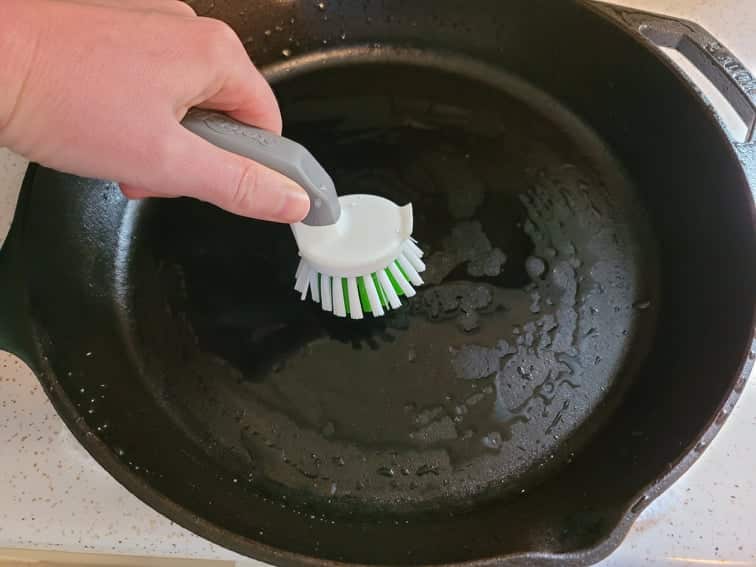
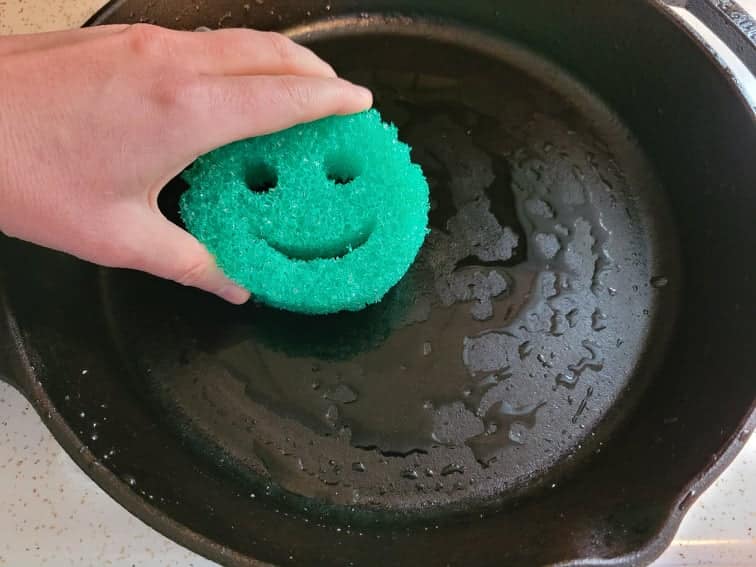
3. If your pan has stuck or burnt-on food residue that isn’t coming off easily when scrubbing and rinsing, you may need to use a salt scrub, boiling water, a chainmail scrubber, or nylon pan scrapers to clean it without damaging the seasoning layer. Check out this article for more detailed cast iron cleaning instructions.
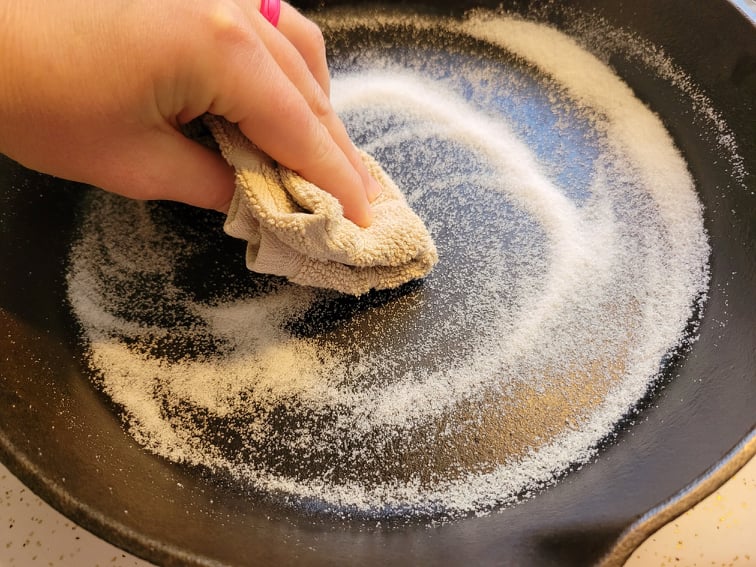

4. After the pan is clean, dry it thoroughly with a towel to remove visible water droplets. Then, place it on a stovetop burner over medium heat or in the oven at 350 degrees for 3 to 5 minutes to evaporate any remaining moisture and kill bacteria. Let the cast iron cool completely before handling it.
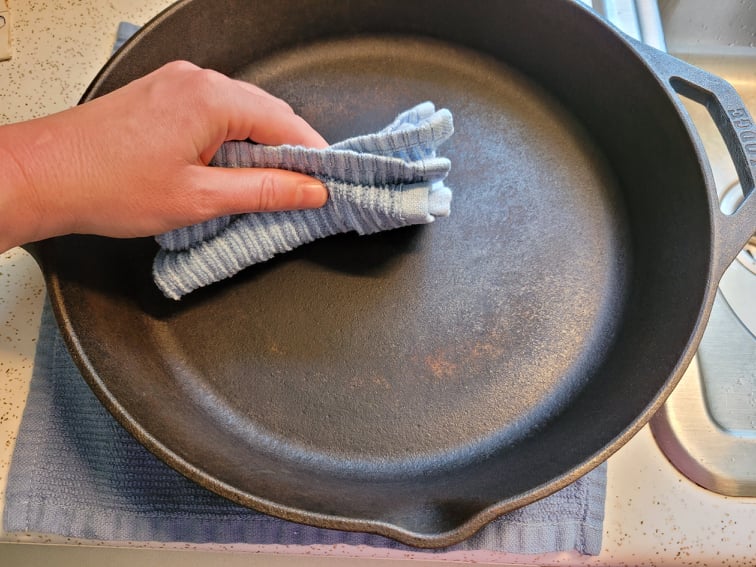
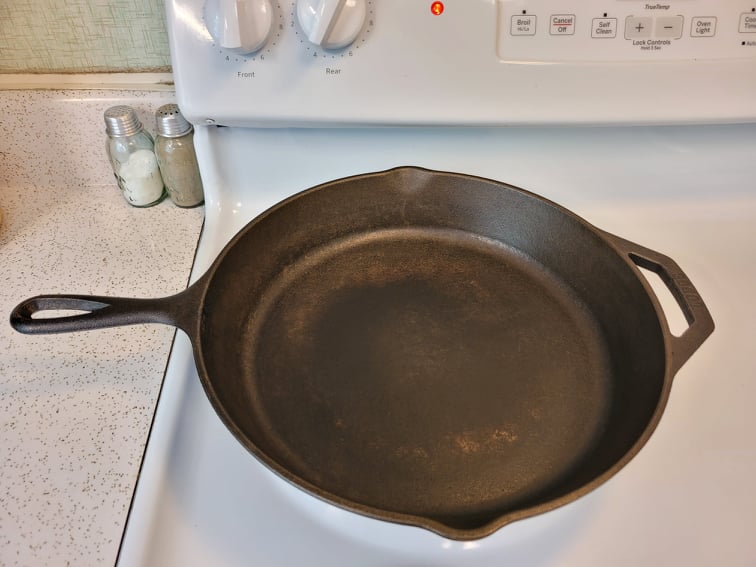
5. Once the cast iron pan is dried, heated, and cool enough to touch, apply about a teaspoon of oil (grapeseed, avocado, or canola) to the cast iron. Use a paper towel or a lint-free cloth (recommended to avoid getting paper towel particles stuck to the pan) to rub a very thin layer of oil all over the inner cooking surface of the pan. Afterward, take a clean section of the towel and buff the pan to remove excess oil. This will prevent it from becoming sticky.
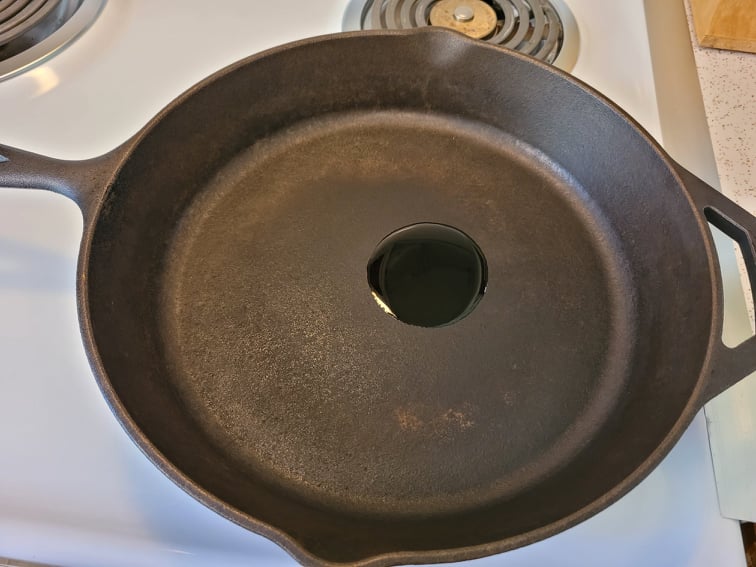
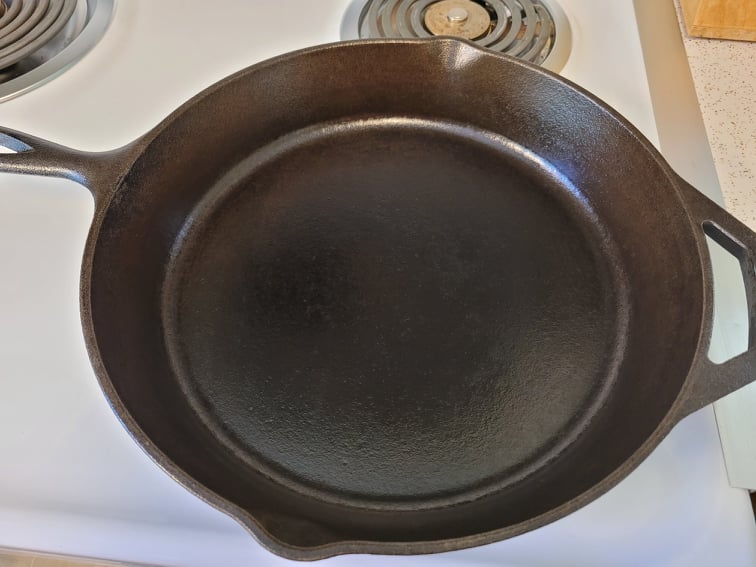
If you’re concerned about the cleanliness of a cast iron pan that’s been properly cleaned, heated, and oiled, but has been sitting in a cabinet for a while, don’t worry. Make sure your pan is visibly clean without any dust or debris, then pre-heat it on the stovetop or in the oven for 3 to 5 minutes before cooking to kill potential bacteria. Additionally, simply cooking with your pan and following food temperature safety guidelines is sufficient to kill bacteria.
Do you take your cast iron skillet or dutch oven camping? Check out my article “How To Clean And Sanitize Cast Iron Cookware While Camping” for step-by-step instructions and photos!
Is It Okay To Clean Cast Iron With Soap?
There may be times you want to use soap to clean your cast iron pan, such as when strong odors linger from recently cooked food (like fish or spicy dishes), if your pan has become dirty or rusty in storage, or before re-seasoning it in the oven. And, despite the evidence presented above, some people aren’t comfortable using cast iron cookware without washing it with soap after each use (and that’s perfectly fine!). So, is it okay to clean cast iron with soap?
The truth is, yes, you can use soap to wash cast iron cookware. Many years ago, when dish soap was lye-based, it was too harsh and would destroy the seasoning layer. This is how the rule, “Never use soap to wash your cast iron!” came about.
Today’s modern dish soaps are much gentler and are safe to use in small amounts on cast iron cookware without removing the seasoning. Sure, it may dry out the cooking surface of your pan more than if you only used water. But, applying a thin coat of oil to the pan after washing and drying and occasionally re-seasoning it solves that problem. Remember, the stronger the seasoning layer on the pan, the more resistant it will be to damage from soap. So, if you choose to use a little bit of soap, that’s perfectly fine.
Still not sure about the soap? Check out what the pros at Lodge Cast Iron have to say.
Summary
Now that you know how high heat kills bacteria and viruses and keeps your cast iron pans sanitary, it’s time to get those skillets and dutch ovens ready for cooking! For more information on how to season your cast iron cookware, check out this helpful article, Seasoning Cast Iron Cookware: A Step-By-Step Guide. The photos and easy instructions make the process a breeze.
Happy cooking! 🙂
This post may contain affiliate links. This means if you click on a link and make a purchase, I will receive a small commission, at no cost to you, that makes it possible for me to keep the Campfires and Cast Iron site up and running. Please see our disclosure policy for details.
